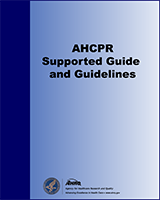NCBI Bookshelf. A service of the National Library of Medicine, National Institutes of Health.
Acute Pain Management Guideline Panel. Acute Pain Management: Operative or Medical Procedures and Trauma. Rockville (MD): Agency for Health Care Policy and Research (AHCPR); 1992 Feb. (AHCPR Clinical Practice Guidelines, No. 1.)
This publication is provided for historical reference only and the information may be out of date.
Methods Used to Develop Clinical Practice Guideline
Three processes were used for the development of the guideline. First was an extensive interdisciplinary clinical review of current needs, therapeutic practices and principles, and emerging technologies for postoperative pain control. This process included review of all pertinent guidelines and standards, receipt of information and opinion from external consultants, a commissioned paper on the ethical aspects of postoperative pain management, an open forum to receive input from concerned parties, and extensive discussion among the panel members.
The second process was a comprehensive review of published research on management of acute postoperative pain and, to a lesser extent, pain associated with trauma and procedure-induced pain. The panel determined that the review should include research related to pain assessment and both pharmacologic and nonpharmacologic treatments. The panel was particularly interested in the effects of the interventions on pain, complications, patient satisfaction, length of stay, and treatment costs.
Articles selected for review were (1) published empirical studies of pain in adults and children after elective and nonelective surgery, pain associated with diagnostic and treatment procedures, and pain associated with post-traumatic injuries and burns; (2) research based articles on measurement and assessment of pain; (3) pain management guidelines; and (4) review articles.
Articles excluded from review included: reports of animal studies and surgical interventions outside the scope of interventions accessible to specialized pain treatment teams or primary caregivers, studies of chronic benign or malignant pain except when also relevant to postoperative or procedural pain, studies comparing within-class analgesic potencies, descriptions of basic pain mechanisms except where specific clinical interventions were tested, editorials and commentaries, discussions of the etiology of pain, studies written in non-English languages, discussions of psychological characteristics, and pure dose-efficacy studies.
The literature review was done at sites in Boston (Harvard University and Massachusetts General Hospital), Baltimore (University of Maryland and The Johns Hopkins University), and Denver (University of Colorado). A group at the School of Public Health, Harvard University performed meta-analyses of drug and TENS studies. Nondrug studies were reviewed at the Baltimore and Denver sites.
The search strategy was developed in conjunction with the National Library of Medicine (NLM). Twelve databases were searched, producing a list of approximately 2,400 drug citations and 2,750 nondrug citations; additional citations were retrieved through other sources, for example another 4,314 nondrug and pain assessment citations and 42 drug citations were obtained from bibliographies of review articles, annotated bibliographies, and the like. From these, approximately 600 drug studies and 500 non-drug articles were reviewed and coded for analysis. Using a best evidence synthesis, the research relevant to particular aspects of pain management was summarized and analyzed. Best- evidence synthesis is based on the best-evidence principle as used in law, in which the same evidence that would be essential in one case might be disregarded in another because better evidence is available (Slavin, 1986). When possible, meta- analyses were performed on the randomized controlled trials. The evidence used for recommendations regarding various interventions in adults is summarized in appendix B (Summary Table of Scientific Evidence for Interventions to Manage Pain in Adults). The table includes the intervention, the type of evidence, and comments regarding use of the intervention.
The third process was peer review of drafts of the guideline and pilot review with intended users. Thirty-three experts in various aspects of pain management reviewed and commented on an early draft of the guideline, using as a framework for their evaluation the attributes of clinical practice guidelines developed by the Institute of Medicine (IOM) of the National Academy of Sciences (Field and Lohr, 1990). Nine additional experts in pain management or practice guideline development reviewed a later draft, using the IOM attributes of guidelines and methods suggested by the Agency for Health Care Policy and Research (AHCPR). Nine additional experts in pain management in children reviewed the section of the guideline on neonates, infants, and children. Pilot review of a later draft was done with physicians, nurses, and others (n = 151) involved in pain management at 15 clinical sites. They reviewed and commented on the clarity, clinical applicability, flexibility, resources or training needed to implement the guideline, and cost implications of the guideline if implemented. A consumer version was developed and tested in clinical sites with 54 patients and 62 nurses and physicians, who reviewed it for clarity and accuracy.
Health policy issues related to ethical, economic, and legal aspects of postoperative pain management were addressed by the panel in several ways. A paper was commissioned on the ethical aspects of postoperative pain management, and the legal implications of pain management were addressed through the limited information available in the literature.
The entire process was anchored by an interdisciplinary panel of experts who used an integrated approach to synthesize the scientific evidence with the knowledge of experts to develop the guideline. Prior to printing of this guidance, drug dosage tables were reviewed by the U.S. Food and Drug Administration. The panel recommends that the guideline be updated 2 years after its publication.
References
- Field, M.D. & Lohr, K.N. (Eds). (1990). Clinical Practice Guidelines: Directions for a New Program. Committee to Advise the Public Health Service on Clinical Practice Guidelines, Institute of Medicine. Washington: National Academy Press.
- Slavin, R.E. (1986). Best-evidence synthesis: An alternative to meta- analytic and traditional reviews. Educational Researcher, 15, 5-11.
- Appendix A - Acute Pain Management: Operative or Medical Procedures and TraumaAppendix A - Acute Pain Management: Operative or Medical Procedures and Trauma
Your browsing activity is empty.
Activity recording is turned off.
See more...
